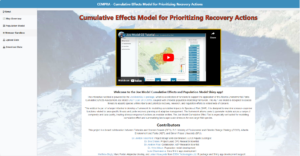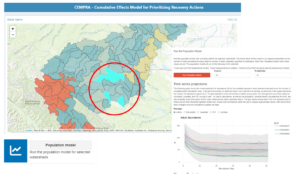Cumulative Effects Model for Priority of Recovery Actions (CEMPRA)
Project Details
Location: |
Western Canada, application could be applied in all regions. | |
Client: |
Fisheries and Oceans Canada (DFO); University of British Columbia; BC Ministry of the Environment | |
Duration: |
2021 – Present | |
Team Member(s): |
Matthew Bayly, Alexandra Tekatch, Marc Porter, Brian Ma, Alejandra Urcelay, Julian Heavyside | |
Practice Area(s): |
Cumulative Effects Assessment | |
Services Employed: |
Decision-Support Systems, Ecological Modelling, GIS Analysis, and Risk and Vulnerability Assessment |
The Problem We Aimed to Solve
Many species are under significant pressure from development and resource use. These effects are coupled with existing pressures from climate change and natural disturbances. Collectively, these pressures can compound and interact, creating problematic cumulative effects on many species and ecosystems. Numerous initiatives have been made to quantify, map, and model cumulative effects across a landscape or region of interest to understand current conditions, high vs. low-risk areas, and potential future conditions under different (hypothetical) development scenarios. However, the applicability of many analytical tools and frameworks is linked to specific geographies, study systems or regulatory frameworks. In addition, many tools or frameworks are too specific or over-generalized, causing researchers to start from scratch with duplicated efforts when undertaking assessments on cumulative effects.
The Cumulative Effects Model for Prioritizing Recovery Actions (CEMPRA) was developed as a flexible modelling framework for species with varying levels of data availability. CEMPRA uses a series of standardized stressor-response functions that link environmental attributes to the system capacity and productivity of a target species/system. The CEMPRA tool is accessible as an open-source R package (https://github.com/essatech/CEMPRA) and R Shiny interactive web application (https://github.com/essatech/CEMPRAShiny). The CEM-PRA tool includes a built-in population modelling framework, which enables users to link key stressors across the landscape to population vital rates for a particular species. This tool is especially useful for species with limited data availability, as it offers a flexible approach and recommends relevant research and recovery actions for any number of geographical units that will most benefit the target species-at-risk.
How We Helped
ESSA worked with project partners and funders – Fisheries and Oceans Canada, the University of British Columbia, the Government of British Columbia, Alberta Environment and Parks, and Simon Fraser University – to design a flexible modelling framework that allows users to upload their own spatial data, habitat stressor values, and stressor-response functions for any region and focal species. The tool, accessed below, is suitable for use anywhere where suitable input data are available. The application includes a user interface for running cumulative effects scenarios; estimating population-level projections and potential impacts on productivity; scrutinizing stressor-response functions; and presenting results in tabular/spatial formats. This tool provides an opportunity for repeatability, flexibility, and simplicity in population-based cumulative effects analysis for any focal system.
Our Project’s Impacts
Elements of the CEMPRA framework have been applied to Athabasca River habitat in Alberta to assess the status and response of Athabasca River Rainbow Trout (Oncorhynchus mykiss) alongside a series of stressor-response curves. The tool has also been parameterized and applied over the Thompson-Nicola region (BC) to evaluate cumulative effects for Chinook salmon (O. tshawytscha), Coho salmon (O. kisutch), and steelhead salmon (O. mykiss). We are happy to provide support to customize CEMPRA for your own applications. You can also access the open-source code for the project below.
- Guidance Document – Downloadable pdf
- Guidance Document Appendices
- Online documentation: https://mattjbayly.github.io/CEMPRA_documentation/
- CEMPRA Web Application: https://essa.shinyapps.io/CEMPRAShiny/
- Source Code (GitHub Repositories):
- R-Package: https://github.com/essatech/CEMPRA
- R-Shiny Application: https://github.com/essatech/CEMPRAShiny
- CEMPRA R-Package Tutorials: https://essatech.github.io/CEMPRA/index.html
- YouTube Video Tutorial Series: Available HERE




